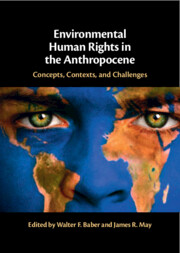Book contents
- Environmental Human Rights in the Anthropocene
- Environmental Human Rights in the Anthropocene
- Copyright page
- Contents
- Contributors
- Acknowledgements
- Introduction
- 1 Framing Environmental Human Rights in the Anthropocene
- 2 Protecting Environmental Human Rights for Future Generations
- 3 Taking Environmental Rights in the Anthropocene Seriously
- 4 The Quest for International Recognition of Environmental Human Rights
- 5 Socioeconomic and Cultural Rights and the Anthropocene
- 6 Local Governments, Climate Action, and Sustainability
- 7 Advancing Environmental Rights through Indigenous Rights
- 8 The Obligation to Curb Carbon Emissions
- 9 Human Rights in the Anthropocene, the Sustainable Development Goals and the Significance of SDG 17, “Partnerships for the Goals”
- 10 The Shape of Environmental Rights Opportunity Structures for the Anthropocene
- Conclusion
- Index
- References
1 - Framing Environmental Human Rights in the Anthropocene
Published online by Cambridge University Press: 02 March 2023
- Environmental Human Rights in the Anthropocene
- Environmental Human Rights in the Anthropocene
- Copyright page
- Contents
- Contributors
- Acknowledgements
- Introduction
- 1 Framing Environmental Human Rights in the Anthropocene
- 2 Protecting Environmental Human Rights for Future Generations
- 3 Taking Environmental Rights in the Anthropocene Seriously
- 4 The Quest for International Recognition of Environmental Human Rights
- 5 Socioeconomic and Cultural Rights and the Anthropocene
- 6 Local Governments, Climate Action, and Sustainability
- 7 Advancing Environmental Rights through Indigenous Rights
- 8 The Obligation to Curb Carbon Emissions
- 9 Human Rights in the Anthropocene, the Sustainable Development Goals and the Significance of SDG 17, “Partnerships for the Goals”
- 10 The Shape of Environmental Rights Opportunity Structures for the Anthropocene
- Conclusion
- Index
- References
Summary
One of the defining characteristics of the Anthropocene, characterised by a new and destructive human–nature relationship, is that for the first time in humanity’s history, the access to a clean and healthy environment is uncertain for large groups of persons and ecosystems. This transformational shift in humankind’s relationship to nature was the catalyst for a debate between scholars, policy-makers and environmental and human rights activists on whether there is a right to the environment and who would be the right and duty holders. To the extent that the intrinsic value and agency of nature is recognised, there is also the related question of the rights of nature, or the right of the environment not to suffer the effects of the Anthropocene.
- Type
- Chapter
- Information
- Environmental Human Rights in the AnthropoceneConcepts, Contexts, and Challenges, pp. 9 - 30Publisher: Cambridge University PressPrint publication year: 2023
References
- 1
- Cited by



